|
Having trouble reading this email?
Download the PDF.

Thematic Focus: Environmental governance
Measuring progress – environmental goals and gaps
Over the last few decades, a great number of environmental goals and objectives have been adopted and a few success stories can be
told. However, despite the growing body of norms and rules, the overall global environmental situation continues to deteriorate. The international
community, having made very uneven progress towards the stated goals, needs to redefine the approach to improve the state of the environment and
foster sustainable development.
Why is this issue important?
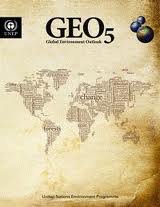
If we measured the world's response to environmental challenges solely by the number of treaties and agreements that have been adopted, then the
situation looks impressive. Over 500 international environmental agreements have been concluded since 1972, the year of the Stockholm Conference and
the establishment of the United Nations Environment Programme (UNEP). These include landmark conventions on issues such as trade in endangered species,
hazardous wastes, climate change, biological diversity and desertification. Collectively, these reflect an extraordinary effort to install the policies,
aims and desires of countries world-wide to achieve sustainable development. Yet despite the impressive number of legal texts and many good intentions,
real progress in solving the environmental challenges themselves has been much less comprehensive, a point clearly underlined in the fifth Global
Environment Outlook (GEO-5) report (UNEP 2012a) and its companion publication "Measuring Progress: Environmental Goals and Gaps" (UNEP 2012b). The
vast majority of goals are found to be 'aspirational' in nature and lack specific targets, which generate obvious difficulties in measuring progress
towards them. In addition, many goals are not supported by adequate data that can be used to measure progress, global freshwater quality being one stark
example. It is clear that if agreements and conventions are to achieve their intended purpose, the international community needs to consider specific
and measurable goals when designing such treaties, while organizing the required data gathering and putting in place proper tracking systems from the outset.
Global Environmental Goals

In a complex and fragmented system of rules, the first challenge is to have a clear understanding of what environmental goals do already exist.
For this purpose, a set of over 300 global environmental goals (GEGs) was compiled by UNEP in cooperation with the Swiss government, resulting from an
extensive consultation among independent experts and a review by government representatives (UNEP 2010). The goals are drawn from existing global and
regional multilateral environmental agreements, such as the Vienna Convention on the Protection of the Ozone Layer and the Montreal Protocol, the
Convention on Biological Diversity (CBD), the Basel Convention on Transboundary Movements of Hazardous Waste, the United Nations Framework Convention
on Climate Change (UNFCCC) and Kyoto Protocol, as well as the United Nations Convention on the Law of the Sea (UNCLOS). Goals are also derived from
non-legally binding instruments such as the 1972 Stockholm Declaration, the 1992 Rio Declaration and Agenda 21, the 2002 Johannesburg Plan of
Implementation, the Millennium Summit Declaration as well as outcomes of conferences convened under the auspices of specialized agencies.
GEO-5 analyzed the set of goals and identified and assessed the 90 most important and appropriate ones for analysis i.e. specifically those geared to
respond to some of the world's most pressing environment and development challenges. It also identified important data gaps for measuring progress
and where possible an assessment of progress was provided, based on the best available scientific findings.
Can we witness any progress to date?
Despite some notable successes, the international community has made very uneven progress in achieving global environmental goals and improving the
state of the environment. There has been little or no progress or further deterioration on about half of the goals and objectives analyzed under the
GEO-5 assessment. Environmental goals currently being addressed but with least success include:
- Climate change. Atmospheric concentrations of greenhouse gases continue to increase to levels that are likely to push global
temperatures to more than 2°C above the pre-industrial average; (Figure 1)
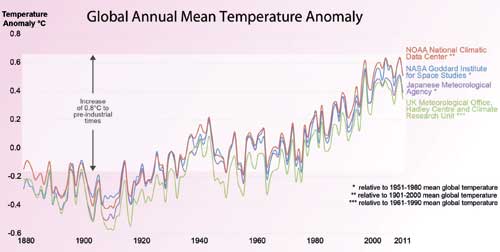
Figure 1: Global mean temperatures are on the rise. Source: NASA 2011, NOAA 2011, UK MetOffice 2011 and JMA 2011.
Full Size Image
- Indoor air pollution. Indoor air pollution from particulate matter (PM) continues to have major health impacts, particularly on women and children;
- Extinction risk of species. The world failed to reach the Millennium Development Goal (MDG) target of reducing the rate of biodiversity
loss by 2010 (UN 2000); (Figure 2)
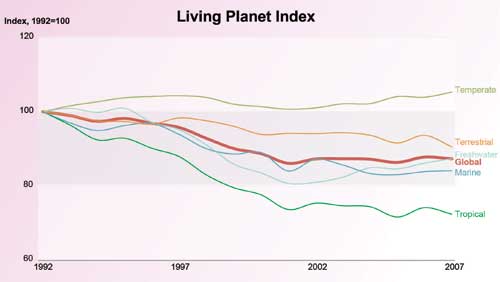
Figure 2: Globally, vertebrate populations are on the decline. Source: WWF/ZSL 2011.
Full Size Image
- Extent and condition of natural habitats, especially coral reefs and wetlands. The condition and extent of natural habitats continue to
decline, with some habitats experiencing declines in extent of 20% or more since 1980 (Butchart et al. 2010);
- Invasive alien species. The numbers of invasive alien species continue to increase, but there are significant gaps in knowledge;
- Access to food. In 2010 about one-sixth of the world's population, an estimated 925 million people, were undernourished (FAO 2010);
- Desertification and drought. Agricultural productivity in drylands continues to decrease because of the effects of desertification and drought (Figure 3);
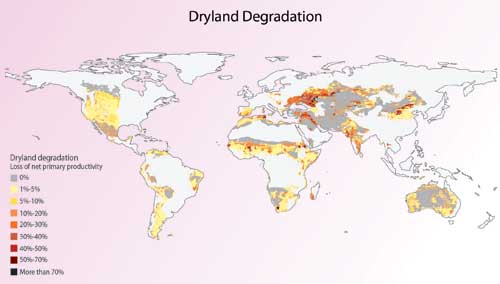
Figure 3: Land degradation results in decreasing agricultural productivity. Source: Zika and Erb 2009.
Full Size Image
- Fish stocks. The proportion of marine fish stocks that are overexploited or collapsed has increased considerably in recent decades;
- Marine pollution. The number of coastal dead zones has increased dramatically; and
- Extreme events. The number of flood and drought disasters has risen since the 1980s, as have the total number of people affected and the level of damage.
On the positive side, most issues for which a specific measurable target exists, achieved at least some progress. This 'need for numbers' was also
highlighted in an earlier GEAS bulletin, calling for time bound, measurable goals and targets and for adequate monitoring of progress towards
achieving them (UNEP 2012c). Examples of goals linked with measurable targets on which progress has been made include:
- The elimination of substances that deplete the ozone layer. The world has nearly eliminated the production and use of substances that deplete
the protective ozone layer in the upper atmosphere (Figure 4), with the Montreal Protocol providing an example of what international cooperation at its
best can achieve. Although full recovery of the ozone layer is not expected until mid-century or later, further expansion of the Antarctic
'ozone hole' has been halted (UN 2011);

Figure 4: Use of substances that deplete the ozone layer has nearly been eliminated. Source: UNEP 2012d.
Full Size Image
- Phasing out lead in gasoline. Nearly all countries have phased out lead in gasoline, another outstanding global success story; and, to some
extent at least (Figure 5);
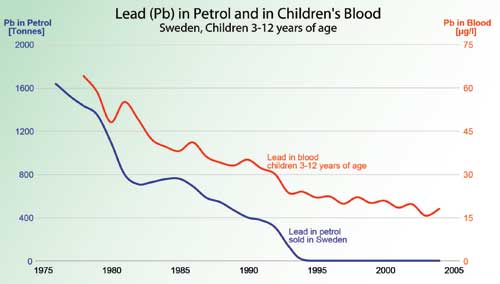
Figure 5: Nearly all countries have phased out lead in gasoline. Source: EEA 2005.
Full Size Image
- Increasing the supply of safe drinking water. The MDG target of halving the proportion of people without sustainable access to safe drinking water by 2015
was already met; however, more than 600 million people will still lack access to safe drinking water in 2015 (WHO 2012).
The world's overall progress towards environmental goals can be further summarized in an Environment Scorecard (Figure 6), an illustrative snapshot showing
how much progress has been made for the most important issues on a scale from green (significant progress) to red (further deterioration). Out of a subset
of 34 selected major global environmental issues included in the Measuring Progress publication (UNEP 2012b), 18 were considered to have made significant
or at least some progress. For 11 issues it was considered that little or no progress was achieved, or even further deterioration has
taken place. Five issues could not properly be assessed due to lack of data.
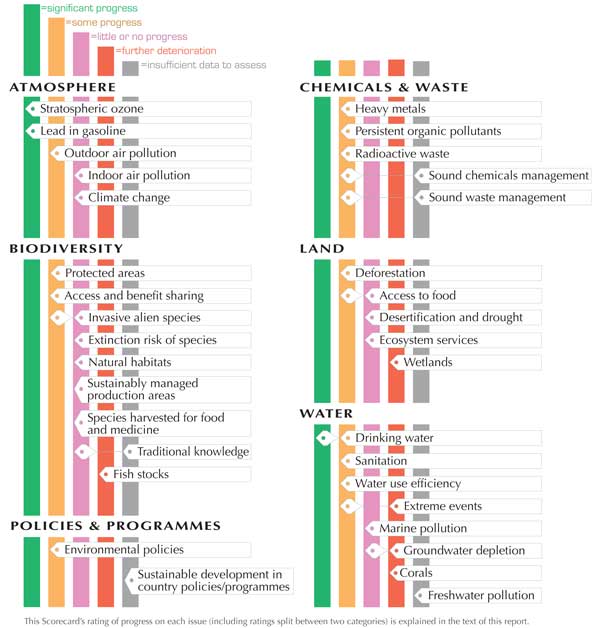
Figure 6: Environment Scorecard 2012. Source: UNEP 2012b.
Full Size Image
The findings presented in Figure 6 lend some support to the adage what is not measured cannot be managed — meaning to say that unless you measure something
you don't know if it is getting better or worse, and you can't manage for improvement if you don't measure to see what is getting better and what isn't.
This holds true in particular for many environmental challenges that can be tackled only by a concerted international effort. The establishment of the
Millennium Development Goals, following the Millennium Summit and its Millennium Declaration in 2000, shows how the adoption of specific, measurable
targets can spur greater efforts to collect and coordinate data on the issues they cover. As the 2011 Millennium Development Goals report states:
'As a result of recent efforts, more data are now available in the international series for the assessment of trends for all MDGs. In 2010, 119
countries had data for at least two points in time for 16-22 indicators; in contrast, only four countries had this data coverage in 2003.
These advances are the result of increased national capacity to venture into new data collection initiatives, as well as to increase the
frequency of data collection.' (UN 2011).
The recent Rio+20 Conference, focusing on 'the future we want', underscored the importance of the MDGs and called for a process to build on
those and develop a broader set of sustainable development goals (SDGs), which should be “action-oriented, concise and easy to communicate,
limited in number, aspirational, global in nature and universally applicable to all countries while taking into account different national
realities, capacities and levels of development and respecting national policies and priorities” (UN 2012). It was also recognized that
progress towards the achievement of the goals needs to be assessed and accompanied by targets and indicators while taking into account
different national circumstances, and that there is a need for integrated and scientifically-based information on sustainable development.
UNEP also pleads for more attention and resources on improved monitoring and environmental data collection in order to provide reliable and
relevant information for decision-making. A new commitment to deal with persistent environmental problems and emerging issues calls for
cooperation, flexibility and innovative solutions (UNEP 2011).
What can be done?
Many global environmental treaties and goals have been developed in a fragmented way, but the interconnectedness between climate change,
water resources, desertification and biodiversity loss, for example, makes isolated governance responses less effective. The fragmented
international framework has also resulted in a heavy burden for some countries, in terms of reporting and fulfilling their obligations.
Measurable targets can encourage the collection and coordination of data, thereby improving our state of knowledge on the subjects they
cover. In addition, it is often difficult to compare the situation in different countries even when data are available, since many countries
follow their own national guidelines when collecting them. For one, efforts should be made to make data from different countries easier to
compare, by promoting the use of international standards and frameworks such as the Framework for Development of Environment Statistics (FDES)
currently being revised by the United Nations and supporting the efforts to compile harmonized databases and make data easily available and
retrievable through dedicated information systems such as UNdata , MDG Indicators or the proposed UNEPLive. Importantly, a considerable number
of research and data gaps need to be addressed in order to track more accurately the state and trends of the global environment. Collection
of data needs to be strengthened for a good number of issues such as freshwater quantity and quality, groundwater depletion,
ecosystem services, land degradation and chemicals and waste.
In conclusion, the international community should consider establishing clear and measurable targets covering a broader range of environmental
challenges, particularly those currently being addressed with least success, those with more irreversible and imminent effects on human
livelihoods, and overall those with greatest relevance to the achievement of sustainable development. Ongoing and future priorities include
promoting, where possible, the use of common standards for data collection and analysis, increased data sharing, consistent time series of
environmental observations, capacity building to strengthen environment statistics and other data in a wider range of countries, and
harnessing new technologies to communicate environmental information effectively to policy makers and the public.
Acknowledgement
Written by: Jaap van Woerdena.
Production and Outreach Team: Arshia Chanderb, Erick Litswac, Kim Gieseb, Lindsey Harrimanb, Michelle Anthonyb, Reza Hussainb, Theuri Mwangic.
Special thanks to David Piperd and Jorn Scharlemanne for reviewing this bulletin.
(a UNEP/DEWA/GRID-Geneva, b UNEP/GRID-Sioux Falls, c UNEP/DEWA/Nairobi, d UNEP/DTIE, e UNEP/WCMC).
References
Butchart, S., Walpole, M., Collen, B., van Strien, A., Scharlemann, J., Almond, R., Baillie, J., Bomhard, B., Brown,
C., Bruno, J., Carpenter, K., Carr, G., Chanson, J., Chenery, A., Csirke, J., Davidson, N., Dentener, F., Foster, M., Galli, A., Galloway, J., Genovesi, P., Gregory, R.,
Hockings, M., Kapos, V., Lamarque, J-F., Leverington, F., Loh J, McGeoch, M., McRae, L., Minasyan, A., Hernández Morcillo, M., Oldfield, T., Pauly, D., Quader, S., Revenga,
C., Sauer, J., Skolnik, B., Spear, D., Stanwell-Smith, D., Stuart, S., Symes, A., Tierney, M., Tyrrell, T., Vié, J-C., Watson, R., 2010. Global biodiversity: Indicators of
recent declines. Science 328: 1164-1168.
EEA, 2005. Data and Maps, Maps and Graphs.
http://www.eea.europa.eu/data-and-maps/figures/lead-concentrations-in-childrens-blood-and-lead-in-petrol-tonne-sold-in-sweden-1976-2003 (accessed on 18.12.2012).
FAO, 2010. The State of Food Insecurity in the World: Addressing Food Insecurity in Protracted Crises.
Food and Agriculture Organization of the United Nations, Rome. http://www.fao.org/docrep/013/i1683e/i1683e00.htm (accessed on 10.12.2012).
JMA, 2011. Global Temperature in 2010. Tokyo Climate Center News – Tokyo climate Center, Japan Meteorological Agency.
http://ds.data.jma.go.jp/tcc/tcc/news/tccnews23.pdf (accessed on 18.12.2012).
NASA, 2011. NASA Research Finds 2010 Tied for Warmest Year on Record. http://www.giss.nasa.gov/research/news/20110112/ (accessed 18.12.2012).
NOAA, 2011. National Climatic Data Center, State of the Climate: Annual 2010 Report – Global Analysis.
Published online January 2011. http://www.ncdc.noaa.gov/sotc/2010/13 (accessed on 18.12.2012).
UK-MetOffice, 2011. 2010 – a near record year. http://www.metoffice.gov.uk/news/releases/archive/2011/2010-global-temperature (accessed on 18.12.2012).
UN, 2000. Millennium Development Goals. United Nations, New York. http://www.un.org/millenniumgoals/ (accessed on 10.12.2012).
UN, 2011. The Millennium Development Goals Report 2011. United Nations, New York. http://www.un.org/millenniumgoals/11_MDG%20Report_EN.pdf (accessed on 10.12.2012).
UN, 2012. The future we want. Outcome document adopted at Rio+20. United Nations, New York.
http://www.uncsd2012.org/content/documents/727The%20Future%20We%20Want%2019%20June%201230pm.pdf (accessed on 10.12.2012).
UNEP, 2010. Existing internationally agreed environmental goals and objectives.
Document UNEP/GC.25/INF/16. United Nations Environment Programme, Nairobi. http://www.unep.org/gc/gc25/info-docs.asp (accessed on 10.12.2012).
UNEP, 2011. Keeping Track of Our Changing Environment: From Rio to Rio+20 (1992-2012).
United Nations Environment Programme, Nairobi. http://www.unep.org/geo/pdfs/Keeping_Track.pdf (accessed on 10.12.2012).
UNEP, 2012a. Global Environment Outlook 5. Environment for the future we want.
United Nations Environment Programme, Nairobi. http://www.unep.org/geo/pdfs/geo5/GEO5_report_full_en.pdf (accessed on 10.12.2012).
UNEP, 2012b. Measuring Progress: Environmental Goals & Gaps. United Nations Environment Programme,
Nairobi. http://www.unep.org/geo/pdfs/geo5/Measuring_progress.pdf (accessed on 10.12.2012).
UNEP, 2012c. The Need for Numbers - Goals, Targets and Indicators for the Environment.
GEAS bulletin March 2012. United Nations Environment Programme, Nairobi. http://www.unep.org/pdf/GEAS_Mar2012_Indicator.pdf (accessed on 10.12.2012).
UNEP, 2012d. The UNEP Environmental Data Explorer. http://geodata.grid.unep.ch (accessed on 18.12.2012).
WHO, 2012. WHO/UNICEF Joint Monitoring Programme (JMP) for water supply and
sanitation: data resources and estimates. World Health Organization, Geneva. http://www.wssinfo.org/data-estimates/introduction (accessed on 10.12.2012).
WWF/ZSL, 2011. The Living Planet Report 2010. http://awsassets.panda.org/downloads/wwf_lpr2010_lr_en.pdf (accessed on 18.12.2012).
Zika and Erb, 2009. The global loss of net primary production resulting from human-induced soil degradation in
drylands. http://www.uni-klu.ac.at/socec/downloads/7_2009_ZikaErb_SoilDegradation_EE_SpecIss_54.pdf (accessed on 18.12.2012).
If you no longer wish to receive this bulletin you can unsubscribe anytime.
Information is regularly scanned, screened, filtered, carefully edited, and published for educational purposes. UNEP does not accept any liability
or responsibility for the accuracy, completeness, or any other quality of information and data published or linked to the site. Please read our
privacy policy and
disclaimer for further information.
|













